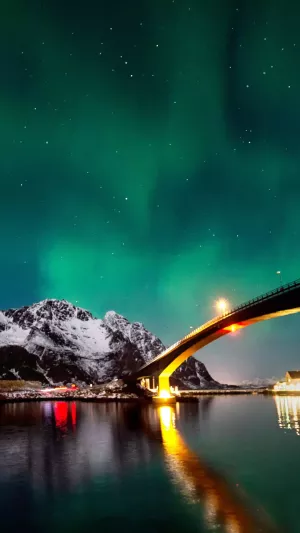Once upon a time, auroras seemed so distant and unattainable that some believed seeing one even once in a lifetime would be enough to leave no regrets.
Today, however, more and more people are sharing their aurora experiences, making the once mysterious phenomenon much more accessible and relatable.
Auroras are gorgeous glowing phenomena that occur due to the flow of solar-charged particles into the Earth's magnetic field, resulting in brilliant and beautiful displays in the high altitudes near the north and south poles. These lights are known as the aurora borealis (or northern lights) in the Arctic and the aurora australis (or southern lights) in the Antarctic. Auroras are generated by high-energy particles from the Earth's magnetosphere or the Sun interacting with atoms in the high-level atmosphere.
Auroras typically appear above latitudes near the Earth's magnetic poles and come in various shapes such as bands, arcs, and rays. These shapes can be stable or constantly changing. Three essential conditions are required for auroras to occur: an atmosphere, a magnetic field, and high-energy charged particles. Without any of these, auroras would not exist.
Interestingly, auroras can display more than six colours. Depending on the altitude, the colours include red, yellow, pink, green, blue, and purple. The most common aurora colour is green, frequently seen in Northern Europe. Green auroras usually result from solar winds colliding with oxygen molecules in the atmosphere at altitudes of about 60 to 150 miles.
Auroras exhibit a variety of colours due to different environmental conditions, climates, and times. Scientists have determined that the colours of auroras are influenced by four main factors:
1. Energy of incident particles: Different energy levels can cause different colours.
2. Distribution of atoms and molecules at different heights: Different gases exist at varying altitudes, affecting the colour.
3. Characteristics of atoms and molecules in the atmosphere: Each type of gas emits different colours when excited.
4. Density of the atmosphere: Closer to the surface, the atmosphere is denser, which impacts the colour seen.
Since Earth is not the only planet in the solar system, it is unsurprising that other planets also experience similar solar storms. Gas giants like Jupiter, Saturn, and Neptune have powerful magnetic fields, but due to their different atmospheric compositions, their auroras display different colours. These planets also have multiple moons, many of which are larger than Earth's moon, further affecting the aurora's appearance.
Although the aurora is beautiful, the energy it releases into Earth's atmosphere can be immense, comparable to the total energy generated by power plants worldwide. This energy can disrupt radio and radar signals. The strong currents generated by auroras can also affect microwave transmission and cause circuits to experience "losses" or even complete failures. Auroras can severely interfere with power transmission lines, causing temporary power outages in some areas.
Harnessing the energy generated by auroras to benefit humanity remains an important scientific mission. Potentially utilizing this natural phenomenon could lead to new advancements in energy and communication technologies, making auroras not only a spectacle of beauty but also a beacon of scientific progress.





